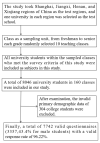Association of Soyfoods or Soybean Products Consumption with Psychological Symptoms: Evidence from a Cross-Sectional Study of Chinese University Students during the COVID-19 Pandemic
- PMID: 36613140
- PMCID: PMC9819589
- DOI: 10.3390/ijerph20010819
Association of Soyfoods or Soybean Products Consumption with Psychological Symptoms: Evidence from a Cross-Sectional Study of Chinese University Students during the COVID-19 Pandemic
Abstract
There is a strong association between soyfoods or soybean product consumption and adolescent health, but there are few studies on the association between soyfoods or soybean product consumption and psychological symptoms among university students. To this end, this study investigated the association between soyfoods or soybean products consumption and psychological symptoms among Chinese university students and analyzed the association between them. A three-stage stratified whole-group sampling method was used to administer questionnaires on soyfoods or soybean products consumption and psychological symptoms to 7742 university students in China. Self-assessment questionnaires were also administered to confounding variables such as basic demographic information, family status, parental education, body mass index (BMI), and moderate and vigorous physical activity (MVPA). The chi-square test, one-way ANOVA, and logistic regression analysis were used to explore the association and differences between soyfoods or soybean products consumption and psychological symptoms. The proportion of Chinese university students' soyfoods or soybean products consumption in ≤one time/week, two-four times/week, and ≥five times/week were 38.81%, 40.24%, and 20.95%, respectively. University students' psychological symptoms problem detection rate was 16.22%. The detection rate of psychological symptoms was lower among university male students (14.75%) than female students (17.35%), and the difference was statistically significant (χ2 = 9.525, p < 0.01). After adjusting for relevant covariates, students with soyfoods or soybean products consumption ≤one time/week (OR = 1.83, 95% CI:1.52, 2.21) had a higher risk of psychological symptoms compared to university students with soyfoods or soybean products consumption ≥five time/week (p < 0.01). During the COVID-19 pandemic, Chinese university students had lower consumption of soyfoods or soybean products and a higher detection rate of psychological symptoms. There was a negative association between soyfoods or soybean products consumption and psychological symptoms. Our study provides a scientific reference for the government and educational decision-making authorities and suggests that education on eating behavior and dietary guidance should be emphasized among university students in the future to maintain a reasonable consumption of soyfoods or soybean products for better physical and mental health development.
Keywords: China; cross-sectional analysis; psychological symptoms; soyfoods; university students.
Conflict of interest statement
The authors declare no conflict of interest.
Figures
References
Publication types
MeSH terms
LinkOut - more resources
Full Text Sources
Medical


